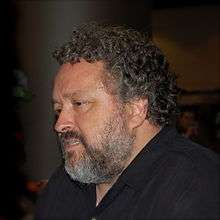Bruce Mau
| Bruce Mau | |
|---|---|
 | |
| Born |
25 October 1959 Sudbury, Ontario, Canada |
| Nationality | Canadian |
| Occupation | Architect |
| Awards |
AIGA Gold Medal (2007) Global Creative Leadership Award (2009) Cooper Hewitt National Design Award (2016) |
| Practice |
Bruce Mau Design Massive Change Network Institute Without Boundaries |
| Projects |
Massive Change S,M,L,XL Seattle Public Library Zone Books |
Bruce Mau (born October 25, 1959) is a Canadian designer. From 1985-2010, Mau was the creative director of Bruce Mau Design (BMD), and the founder of the Institute without Boundaries. In 2010 Mau went on to establish The Massive Change Network in Chicago. He started as a graphic designer but later focused on architecture, art, museums, film, eco-environmental design, and conceptual philosophy.[1]
Life and career
Mau was born in Sudbury, Ontario. He studied at the Ontario College of Art & Design in Toronto, but left prior to graduation in order to join the Fifty Fingers design group in 1980. He stayed there for two years, before crossing the ocean for a brief sojourn at Pentagram in the UK. Returning to Toronto a year later, he became part of the founding triumvirate of Public Good Design and Communications. Soon after, the opportunity to design Zone 1/2 presented itself and he left to establish his own studio, Bruce Mau Design. Zone 1/2: The Contemporary City, a complex compendium of critical thinking about urbanism from philosophers such as Gilles Deleuze and Paul Virilio, architects Rem Koolhaas and Christopher Alexander remains one of his most notable works. The firm has produced work for the Andy Warhol Museum, the Art Gallery of Ontario and the Gagosian Gallery.[2] Mau remained the design director of Zone Books until 2004, to which he has added duties as co-editor of Swerve Editions, a Zone imprint. From 1991 to 1993, he also served as creative director of I.D. magazine.
From 1996 to 1999, he was the associate cullinan professor at Rice University School of Architecture in Houston. He has also been a thesis advisor at the University of Toronto’s Faculty of Architecture, Landscape & Design; artist in residence at California Institute of the Arts; and a visiting scholar at the Getty Research Institute in Los Angeles. He has lectured widely across North America and Europe, and currently serves on the International Advisory Committee of the Wexner Center in Columbus, Ohio.
In addition, Mau is an honorary fellow of the Ontario College of Art & Design and a member of the Royal Canadian Academy of Arts. He was awarded the Chrysler Award for Design Innovation in 1998, and the Toronto Arts Award for Architecture and Design in 1999. In 2001 he received an Honorary Doctor of Letters from the Emily Carr University of Art and Design in Vancouver. He is also a Senior Fellow of the Design Futures Council.[3]
In 1998, Mau produced a 43-point program called an Incomplete Manifesto for Growth that attempts to help designers and creative folks think about their design process. The manifesto has been widely circulated on the web since then.[4]
In 2006, he participated in the Stock Exchange of Visions.
Mau is married to Aiyemobisi “Bisi” Williams (1966) and they have three daughters named Osunkemi, Omalola, and Adeshola (named in honor of Bisi Williams’s Nigerian heritage).[1]
As of 2007, Mau was in residence at The School of the Art Institute of Chicago, in the Architecture, Interior Architecture, and Design Objects Department.
In 2009 Bruce Mau and Bisi Williams founded the Massive Change Network.[5]
In the 2010s, Bruce Mau Design was involved in the redevelopment and redesign of Ontario's ONroute service centres.[6]
As of November 19, 2015, Bruce Mau is the Chief Design Officer for Freeman, a brand experience company and service contractor.[7]
At the Philadelphia Museum of Art, Mau exhibited his designs for books, graphics, and social projects. He received the Museum's Design Excellence Award in 2015.[8] Mau received the Cooper Hewitt 2016, National Design Award for Design Mind, for his impact on design theory, design practice and/or public awareness.[9][10]
Graphic design
- S,M,L,XL with Rem Koolhaas (1995) ISBN 0-7148-3827-6
- Life Style (2000) ISBN 1-885254-01-6
- Massive Change (2004) ISBN 0-7148-4401-2
- Eye, No. 15, Vol. 4, Winter 1994.
See also
References
- 1 2 Froelke Coburn, Marcia (July 6, 2010). "Bruce Mau: From Innovative Graphic Designer to World-Class Conceptualist". Chicago Magazine. Chicago Tribune Media Group. Retrieved June 4, 2014.
- ↑ Fast Company http://www.fastcompany.com/magazine/39/mau.html
- ↑ Design Futures Council Senior Fellows http://www.di.net/about/senior_fellows/[]
- ↑ http://www.fastcompany.com/magazine/39/maumanifesto.html Incomplete Manifesto for growth
- ↑ "Massive Change Network". Massive Change Network. Retrieved 21 October 2011.
- ↑ "ONroute in Ontario". Toronto Sun, January 31, 2012.
- ↑ http://pressrelease.freemanco.com/freeman-brings-design-thinking-to-the-forefront-of-the-events-industry/
- ↑ "Designing the Future with Bruce Mau". University of Pennsylvania. University of Pennsylvania School of Design. Retrieved 18 October 2016.
- ↑ "Freeman's Chief Design Officer Bruce Mau Recognized with Cooper Hewitt 2016 National Design Award: Design Mind". News Channel 10. Frankly Media and Raycom Media. Retrieved 2016-05-05.
- ↑ Lasky, Julie (2016-05-05). "National Design Awards Announced". The New York Times. ISSN 0362-4331. Retrieved 2016-05-05.
External links
| Wikiquote has quotations related to: Bruce Mau |
- Bruce Mau Design Inc. Mau's Toronto-based design studio
- Incomplete Manifesto for Growth
- Massive Change Network
- Massive Change BMD's Massive Change Project.
- Massive Change In Action The Massive Change educational project.
- Institute without Boundaries
- Zone Books
- AIGA on Bruce Mau